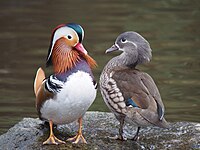
Photo from wikipedia
Abstract Species occurrence can be affected by the availability of environments that fit within the limits of variation of its niche and by interaction with other species. Modifications in the… Click to show full abstract
Abstract Species occurrence can be affected by the availability of environments that fit within the limits of variation of its niche and by interaction with other species. Modifications in the environment, especially those caused by mankind, are considered the leading cause for species extinction. Such a response from the species is not random, with patterns that can follow functionality and/or morphology of each taxa. In this context, the objective of this study was to assess how environmental factors affect adult Odonata species, testing the hypotheses: a) that the environment acts as a filter upon the species by means of facilitating or excluding specific characteristics and b) that because of the order’s requirements for thermoregulation and reproduction, thorax width and oviposition type are the variables most affected in the group. A total of 97 streams were sampled in eastern Amazonia, distributed along a gradient of different states of preservation, from completely preserved to heavily impacted by plantations and livestock. Six functional characteristics and seven environmental descriptors were selected, and to assess their relationships, a combination of Fourth Corner and RLQ analysis was used. The Habitat Integrity Index was the descriptor with the biggest impact on the Odonata community, presenting a negative correlation with wing width, thorax width and exophytic oviposition, and a positive correlation with endophytic oviposition. Macrophyte cover was the next most relevant environmental descriptor, showing a negative correlation with abdomen length, and positive correlation with thorax width and exophytic oviposition. The results show that poorly preserved environments favour the occurrence of organisms with a wider thorax and the substitution of endophytic oviposition with the exophytic type. Since changes to the environment do not usually alter Odonata richness but rather the composition, these results show a favouritism for groups with mentioned characteristics, such as Libellulidae, to the detriment of other groups (especially Zygoptera), which can result in community homogeneity and both biodiversity and functional loss. The maintenance of well-preserved environments is therefore indispensable in assuring Odonata biodiversity, as well as the best way to preserve the different behavioural and ecophysiological groups in the order. The Odonata community’s response, directed through its morphological and behavioural characteristics, sheds light on ecological patterns, and thus the addition of oviposition habits in conservation measures aimed at preserving the order can render them more adequate, as this is a critical aspect of population maintenance and colonization of new sites.
Journal Title: Ecological Indicators
Year Published: 2019
Link to full text (if available)
Share on Social Media: Sign Up to like & get
recommendations!